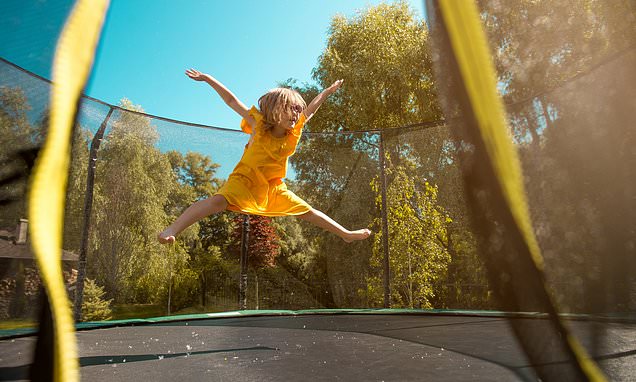Trampolines are behind HALF of all activity-related childhood A&E admissions in UK
- Analysis looked at more than 1.4million trampolining injuries around the world
- Included admissions among under-14s in Oxfordshire between 2012 and 2014
- Researchers concluded trampolining ‘poses a significant risk’ to youngsters
Half of all childhood injury A&E admissions in the UK are because of trampolining accidents, figures suggest.
An analysis of nearly 1.4million trampolining injuries around the world concluded the activity ‘poses a significant risk’ to youngsters.
While trampolines have been a family garden staple for decades, trampoline parks have enjoyed a boom in popularity in recent years.
There are now hundreds of indoor and outdoor parks – a popular venue for birthday parties – across the UK, compared to just a handful a decade ago.
The study found children visiting trampoline centres were twice as likely to suffer broken bones or sprains as those using them at home.
This is because ‘the higher tensile strength used in commercial trampoline centres may produce a harder bounce’, creating a bigger jump and putting more pressure on bones.
The UK arm of the research, by the University of Sydney, looked at A&E admissions among children under 14 in Oxfordshire from January 2012 to March 2014.
Overall, about half of all physical activity-related accidents were linked to trampolining — making it more dangerous than playing football or rugby.

Half of all childhood injury A&E admissions in the UK are because of trampolining accidents, figures suggest (file)
Around 55 per cent of all injury-related A&E visits for girls were from trampolining, while for boys the figure was 38 per cent.
The findings were published in the British Medical Journal’s (BMJ) Injury Prevention journal.
Researchers analysed data from 11 studies carried out in the US, South Korea, Canada, the UK, Singapore, Australia and New Zealand.
Writing in the paper, the researchers said: ‘Trampolines are among the most common gifts to school-age children.
‘However, trampolining poses a significant risk of injury, which accounts annually for nearly 100,000 paediatric emergency visits in the US.
‘Trampoline injuries explain 50 per cent of admissions to emergency departments in children under 14 in the UK. In Australia, almost 15,000 children were hospitalised for trampoline injuries between 2002 and 2011.’
Injuries sustained by children at trampoline parks tended to be more severe as well as common.
Although there was no difference in the risk of hospital admission, the need for surgery was nearly twice as high at public centres.
The study found children who used trampoline parks tended to be older than those using them at home.
As well as being made of different materials, the researchers said the higher rate of severe injuries could be due to children taking more risks at trampoline parks.
The firmer mats mean people can get more air time and children may be tempted to perform tricks such as backflips.
Professor Guy Eslick, author of the report, said the study demonstrated the need for mandatory safety regulations at public trampoline centres.
He said: ‘Presently, safety guidelines are not legislated for commercial trampoline centres anywhere in the world. Most trampoline centres only demand a user’s injury liability waiver before admission.’
Arm injuries, cuts and concussions were more common in garden trampolines, which experts said was because trampoline centres often have padding to cushion falls.
‘Wasteful’ NHS spent £100MILLION on prescription paracetamol, aspirin and ibuprofen last year
More than £100million was spent on prescribing common drugs like paracetamol last year, despite them being available for pennies on the high street.
Official data also shows the NHS in England spent thousands on illicit substances like cocaine for use as an anaesthetic.
It comes just a day after Health Secretary Sajid Javid promised that ‘every pound’ in the NHS will be ‘well spent’ going forward.
In total the NHS spent £9.69billion on prescription drugs in England for the 2021/22 financial year.
That’s despite the health service banning GPs and other prescribers from dishing out medications which patients themselves can buy cheaply in shops since 2018.
Think-tanks today said taxpayers will be dismayed by the NHS’s ‘wasteful’ spend on ‘pointless prescriptions’ in light of the recent national insurance tax hike.
Paracetamol made up £73.7million of the spend, being prescribed over 16million times, at about £4.50 a pack — roughly 15 times the price of a pack of paracetamol at supermarket Tesco.
Source: Read Full Article
